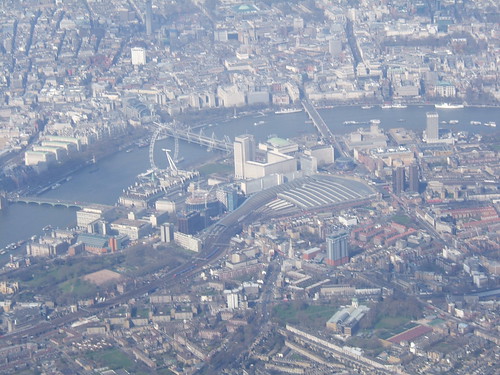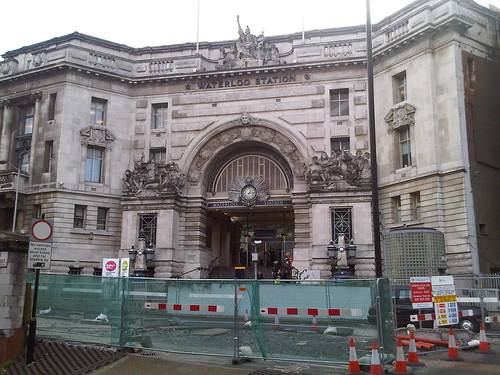Brought up in the Midlands in the early days of the post-war Nationalised railway, the former Southern Railway was very much a 'foreign railway' to me. It was some time before I started to discover some of the history of the lines in the south of the country.
Then and Now
The 'Golden Arrow' leaves Victoria at 10.00 a.m. in steam days headed by a Bulleid 'Pacific' (Photo: British Railways).
Approaching Victoria in 2011 on the Brighton Lines, looking towards station.
The tower of the building designed by Albert Lakeman in 1939 for Imperial Airways is visible in both pictures. After the Second World War, Imperial Airways was nationalised and became part of British Overseas Airways Corporation. The building is now occupied by the National Audit Office.
Click for larger image
Victoria Station in a 2009 aerial view. The terminus is in the middle of the picture, with the approach tracks towards the lower left. The 'country end' of the station is virtually buried under modern developments. Hyde Park is top left, with Green Park and Buckingham Palace to the right. Centre right is Westminster Cathedral (Roman Catholic), designed in the late 19th century by John Francis Bentley in Early Christian Byzantine style.
Brief History
Whereas many of London's terminal stations served one railway company, Victoria ended up serving a number. The London Brighton and South Coast Railway, South Eastern Railway and the London and Chatham Railway initially terminated at London Bridge but co-operated in constructing a new route which crossed the Thames to terminate in what became Victoria Station. The London Brighton and South Coast Railway accomodated itself on the platforms on the western side. The eastern platforms were initially dual gauge and used by the Great Western Railway, the South Eastern Railway and the London and Chatham Railway. These last two railways worked together fairly closely, before amalgamating formally as the South Eastern and Chatham Railway. Traffic growth necessitated widening the Grosvenor Bridge over the River Thames to accommodate additional lines, producing a number of routes which criss-crossed one another south of the Thames, as shown in the 1914 map below.
Click for larger image.
Details of the junctions between various railways in the vicinity of Victoria. This diagram is one of a series prepared by the Railway Clearing House in 1914 which appear in the reprint 'Pre-Grouping Railway Junction Diagrams 1914', published by Ian Allen (ISBN 0 7110 1256 3).
Part of the portland stone facade of the 'Chatham' side of Victoria Station (as rebuilt by the S.E.C.R. and with 'SOUTHERN RAILWAY' branding added after the 'Grouping'), viewed from the street.
Part of the 'Brighton' side of Victoria Station, viewed from the street but well-hidden by ongoing "improvements". The L.B.S.C.R. station building, built in 'Renaissance' style, is on the left with the adjacent Grosvenor Hotel, originally intended for rail travellers, on the right.
The 1921 Railways Act created the 'Big Four' (L.M.S., G.W.R., L.N.E.R. and S.R.). The Southern Railway brought together the London Brighton and South Coast Railway, the South Eastern and Chatham Railway and the London and South Western Railway. Upon Nationalisation in 1948, the Southern Region of British Railways absorbed the assets of the Southern Railway. Even today, Victoria largely operates as two stations side-by-side - the Central Section dealing with the Brighton lines and the Eastern Section serving the Chatham lines.
Signalling
The former power signal box at Victoria controlling the Central Lines. The area is now controlled from Victoria Area Signalling Control (which is actually at Clapham Junction).
Before the Victoria Area Signalling Control was brought into use at Clapham Junction in 1980, Victoria was served by two power boxes. The Eastern Section had a separate signal box with a G.R.S. power frame. This lasted until 1979 when control passed for a short time to a temporary panel in the Victoria Central power box.
The Southern Railway had installed signalling power frames of Westinghouse Style 'K' at various locations. The Style 'K' retained mechanical interlocking between the miniature levers. The later Style 'L' 'All Electric' power frames introduced electrical interlocking between levers and the Southern Railway was an early adopter of the new design. In 1937, an order was placed for a 225-lever frame for Victoria Central with 51 point levers, 148 signal levers, 2 special levers and 24 spare levers. This was commissioned in June 1939 and continued in service until 1980. A temporary panel then took over until the new Victoria Area Signalling Control was brought into use at Clapham Junction.
For more information about the Style 'L' frame, refer to Book Reference [3] 'The Style L Power Frame'. For more information about the Eastern Section control, click here and for the about Victoria Central control, click here. These pages are part of the splendid site 'Westinghouse Brake and Saxby Signal Co. Ltd miniature power lever frames'.
The Golden Arrow
I visited Victoria in the steam era and saw the famous 'Golden Arrow' Pullman train, headed by a gleaming rebuilt Bulleid 'Pacific'. The train might have been exotic, but the station surroundings seemed very ordinary and I remember it looking very like the black-and-white picture above.
The 'Golden Arrow' is no more, but Victoria still entertains Pullman trains (sometimes steam hauled) operated by VSOE as 'The British Pullman'. I never did get to travel on the 'Golden Arrow' and (so far) I've not travelled on the 'British Pullman' but I have had a conducted tour of the 'British Pullman' rolling stock which is described here.
External web sites
London Victoria Station (Wikipedia).
Victoria (Network Rail).
External Links
London and South Western Railway (Wikipedia).
South Eastern and Chatham Railway (Wikipedia).
London, Brighton and South Coast Railway (Wikipedia).
Book References
[1] 'London's Termini' by Alan A. Jackson, published by David & Charles (0 330 02746 6).
[2] 'Railway Track Diagrams Book 5: Southern and TfL' Third Edition, published by TRACKmaps (ISBN 978-0-9549866-4-3).
[3] 'The Style L Power Frame' written and published by J. D. Francis 1989 (ISBN 0 9514636 0 8).
[4] 'History of the Southern Railway' by C. F. Dendy Marshall, revised by R. W. Kidner reprinted 1982 by Ian Allen (ISBN 0 7110 0059 X).
[5] 'Great Locomotives of the Southern Railway' by O. S. Nock, Guild Publishing, 1987 edition by Book Club Associates.
[6] 'Southern Steam' by O. S. Nock, published by David & Charles (ISBN 0 7153 5235 0).
[7] 'London's Termini' by Alan A. Jackson, published by David & Charles (0 330 02746 6).
Maps
Details of the railways around Victoria today are shown in the 'Quail Track Diagrams':-
'Railway Track Diagrams Book 5: Southern and TfL' Third Edition, published by TRACKmaps (ISBN 978-0-9549866-4-3).
My Pictures
London: Victoria.
London: former 'Southern' lines.
London's Railways.

































